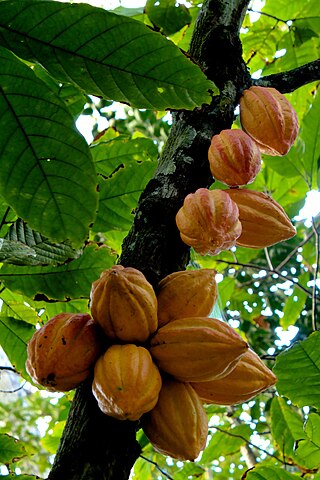Template:Species-2012-06-1
Species of the month
editCocoa Tree
editSome facts on this tree:
Tree height: 4-8 meters.
Flower: 1–2 cm. in diameter, with pink calyx.
Fruit, called also Pod: Up to 30cm long, yellow, brown and even purple in colour, usually with 10 ribs. Each pod contains 20 to 60 beans up to 3 cm long, which are usually arranged in five rows surrounded by a sugary pulp.
Range: Native to the deep tropical region of the Americas. Cultivated also in Africa and Asia between ±15° latitude.
Life-span: Up to 100 years, but cultivated trees are considered economically productive for only about 60 years.
First described: By Swedish naturalist Carolus Linnaeus in 1753.
Take some Theobroma cacao seeds, grind them to a smooth butter, add a sweetener and other flavorings, such as vanilla, and what do you get? You probably guessed: it's the beloved chocolate. This tree grows all over the tropics, especially in Western Africa where 70% of the cocoa world production is made in countries such as the Ivory Coast and Ghana. Cacao trees are quite picky about their environment. They require moist, nutrient-rich, well-drained soil and partial sunlight. The plant is also sensitive to pests and scientists are crossing West African cocoa trees with their wild South American ancestors to create disease-resistant trees, which will lead to fewer chemicals. Currently, 4 million metric tons of beans worth more than $4 billion are produced each year. The meaning of the scientific name is 'food of the gods' in Greek. Mayan and Aztec nobles drank their cocoa beans ground and brewed with chillies and in the Aztec empire the beans were used as money. It arrived in Spain in the 16th century, and gradually grew in popularity especially with the ladies of the Spanish court. The cacao tree is a member of the Malvaceae or mallow family which contains over 200 genera with close to 2300 species including the kapok, mallow, cola and hibiscus.
See also: Species of previous months
